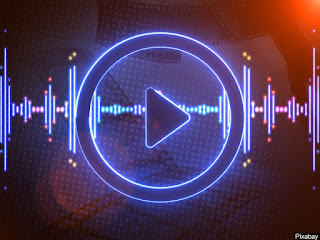It is fair to say that a collaboration album from two musicians like Peter Baumann and Paul Haslinger is no ordinary event in the timeline of electronic music history. In latter history, both names occupy a significant section with not just their time spent as members of the veritable institution that was and is Tangerine Dream, but also with their solo careers.
First of all, one must stress: this is not an album that rides some fashionable wave of mainstream electronica. Also, whilst it does have some not quite veiled references to musical elements one first heard in Tangerine Dream compositions, Neuland is not a recreation of some period from that band's history.
Something that may instantly captivate the listener, right from the first track, is the very evident pedigree of the two musicians. Whilst both had notable solo careers, the immediately recognisable Tangerine Dream DNA is very much present in the opening track's sequencer work.
The sequenced background and vintage-sounding lead propels us back to the mid-to-late 1970s TD sound. Thus, the opening track (Cascade 39) is in many ways pointing to a fondly remembered past rather than futuristic soundscapes.
Things change several times as the album progresses - already the second track, Road To Danakil, shows that darker atmospherics and thundering electronics are not at all alien to the two composers. In a way, one might recognise a certain gravitas in the arrangements and sonic choices, familiar to those who have heard the Machines Of Desire recent solo album by Peter Baumann.
One could always play the game of trying to guess which musician was responsible for which parts of the compositions one hears, and in this collaboration album, too it could be a rewarding game.
Clearly, there are solid sonic fingerprints from Baumann, the playful melodic motifs that punctuate the electronic soundscapes are unmistakably his - and make one think of his solo albums of yesteryear. Such motifs turn up in many places, from the aforementioned Road To Danakil to Dream 9 to Counting On Time (where not only the melodic pattern, but also the digital choir-like choice of synth patch is a direct pointer to e.g. Machines Of Desire).
The way in which Baumann & Haslinger can build effortless-sounding, fluid, and constantly evolving sonic ambiences is very apparent in the mentioned Counting On Time, and Long Now Icarus or Measure 3.
Something that starts as an almost ambient track can evolve into a playful, than animated track like 54_NOVO, with catchy melodic patterns, too.
The final track, Longing In Motion, is another example of something that evolves from the ambiences of vast cosmic spaces to a pulsating, then rather majestic, piece of electronic dreamscape. The forces that were unleashed in tracks like Dream 9 are held back here and gradually, subtly added to the discourse, with gentle pulsating patterns that make us feel firmly rooted in a Berlin School-style electronic Universe.
When it comes to the overall sound world of the album, a couple of aspects are worthy of highlighting.
First of all, it has a quite minimalist feel, in the sense that the sparseness of the arrangements might really stand out to some listeners.
This is not electronica with vast layers of sounds, everything is kept very distinctive and one really can very often count on one hand how many simultaneous elements are at play in the arrangements.
This creates an aesthetic where every detail stands out, as the very translucent and sparse arrangements do not want to, and cannot, mask or blur anything. The listener is not drowned in electronic showing-off of might, instead, one is allowed to contemplate often isolated sparse shimmers and specks of light in vast cosmic darkness.
One example is M-Tron Field, where often just one synth patch with just a few well-isolated distinct notes hover above a background pad (or not even that, just silence and vast reverberations). Every individual sound is allowed to take shape and float around, if it so wishes to, without being drowned in huge electronic orchestrations.
The other, more technical, aspect is the choices made for the depiction of rather astral spaces. Yes, there are some delays and phasing, however most often the task of suggesting vast sonic spaces goes to immense reverbs. Both percussive and melodic synth sounds can feel as they occupy a space only inhabited by some vast galaxies... and with such acoustic backdrop, the vintage leads (like the fiery solo in Measure 3) stand out even more and grab one's attention.
For an even more general and overall remark, there is an element of Neuland that is highly commendable even if someone's tastes or preconceptions might not actually match what one hears on this album.
Peter Baumann and Paul Haslinger, in a stellar collaboration like this and with the very special pedigree they have, could have chosen to produce a trendy, even perhaps safe, mainstream electronica album.
They haven't - and it is a positive.
It is an honest album, that is consistent with their individual styles and compositional preferences, as proven also by the recognisable musical and technological choices they made for this album.
In today's EM landscape it is refreshing to hear such individualist approach and risk taking instead of some drive to fit a successful-sounding pre-existing mould.






























